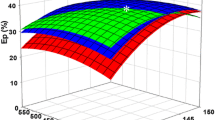Abstract
A total monosaccharide concentration of 59.0 g/L, representing 80.1 % conversion of 73.6 g/L total fermentable sugars from 160 g dw/L G. amansii slurry was obtained by thermal acid hydrolysis and enzymatic hydrolysis. Subsequent adsorption treatment using 5 % activated carbon with an adsorption time of 2 min was used to prevent the inhibitory effect of 5-hydroxymethylfurfural (HMF) >5 g/L in the medium. Ethanol production decreased with increasing salt concentration using C. tropicalis KCTC 7212 non-acclimated or acclimated to a high concentration of salt. Salt concentration of 90 psu was the maximum concentration for cell growth and ethanol production. The levels of ethanol production by C. tropicalis non-acclimated or acclimated to 90 psu high-salt concentration were 13.8 g/L with a yield (YEtOH) of 0.23, and 26.7 g/L with YEtOH of 0.45, respectively.





Similar content being viewed by others
References
Cho HY, Ra CH, Kim SK (2014) Ethanol production from the seaweed, Gelidium amansii using specific sugar acclimated yeasts. J Microbiol Biotechnol 24:264–269
Agbor VB, Cicek N, Sparling R, Berlin A, Levin DB (2011) Biomass pretreatment: fundamentals toward application. Biotechnol Adv 29:675–685
Park JH, Hong JY, Jang HC, Oh SG, Kim SH, Yoon JJ, Kim YJ (2012) Use of Gelidium amansii as a promising resource for bioethanol: a practical approach for continuous dilute-acid hydrolysis and fermentation. Bioresour Technol 108:83–88
Quemener B, Lahaye M (1998) Comparative analysis of sulfated galactans from red algae by reductive hydrolysis and mild methanolysis coupled to two different HPLC techniques. J Appl Phycology 10:75–81
Aguilar R, Ramìrez JA, Garrote G, Vázquez M (2002) Kinetic study of the acid hydrolysis of sugar cane bagasse. J Food Eng 55:309–318
Modig T, Liden G, Taherzadeh MJ (2002) Inhibition effects of furfural on alcohol dehydrogenase, aldehyde dehydrogenase and pyruvate dehydrogenase. Biochem J 363:769–776
Sanchez B, Bautista J (1998) Effects of furfural and 5-hydroxymethylfurfural on the fermentation of Saccharomyces cerevisiae and biomass production from Candida guilliermondii. Enzyme Mircrob Technol 10:315–318
Lee JM, Venditti RA, Jameel H, Kenealy WR (2011) Detoxification of woody hydrolyzates with activated carbon for bioconversion to ethanol by the thermophilic anaerobic bacterium Thermoanaerobacterium saccharolyticum. Biomass Bioenergy 35:626–636
Varela JCS, Mager WH (1996) Response of Saccharomyces cerevisiae to changes in external osmolarity. Microbiology 142:721–731
Marger WH, Siderius M (2002) Novel insights into the osmotic stress response of yeast. FEMS Yeast Res 2:251–257
Yancey PH (2005) Organic osmolytes as compatible, metabolic and counteracting cytoprotectants in high osmolarity and other stresses. J Exp Biol 208:2819–2830
Silva-Graça M, Neves L, Lucas C (2003) Outlines for the definition of halotolerance/halophily in yeasts: Candida versatilis (halophila) CBS4019 as the archetype. FEMS Yeast Res 3:347–362
Sanchez-Machado DI, Lopez-Cervantes J, Paseiro-Losada P, Lopez-Hernandez J (2004) Fatty acids, total lipid, protein and ash contents of processed edible seaweeds. Food Chem 85:439–444
Mandels M, Andreotti R, Roche C (1976) Measurement of saccharifying cellulase. Biotechnol Bioeng Symp 6:21–23
Kubicek CP (1982) β-glucosidase excretion by Trichoderma pseudokoningii correlation with cell wall bound β-1,3-glucanase activities. Arch Microbiol 132:349–354
Jol CN, Neiss TG, Penninkhof B, Rudolph B, De Ruiter GA (1999) A novel high-performance anion-exchange chromatographic method for the analysis of carrageenans and agars containing 3,6-anhydrogalactose. Anal Biochem 268:213–222
Omori T, Ogawa K, Shimoda M (1995) Breeding of high glycerol-producing Shochu yeast (Saccharomyces cerevisiae) with acquired salt tolerance. J Ferment Bioeng 79:560–565
Ra CH, Jeong GT, Shin MK, Kim SK (2013) Biotransformation of 5-hydroxymethylfurfural (HMF) by Scheffersomyces stipitis during ethanol fermentation of hydrolysate of the seaweed Gelidium amansii. Bioresour Technol 140:421–425
Cho YK, Kim HJ, Kim SK (2013) Bioethanol production from brown seaweed, Undaria pinnatifida, using NaCl acclimated yeast. Bioprocess Biosyst Eng 36:713–719
Alepuz PM, Cunningham KW, Estruch F (1997) Glucose repression affects ion homeostasis in yeast through the regulation of the stress-activated ENA1 gene. Mol Microbiol 26:91–98
Acknowledgments
This research was supported by the Basic Science Research Program through the National Research Foundation of Korea (NRF) funded by the Ministry of Education (2013R1A1A2059095).
Author information
Authors and Affiliations
Corresponding author
Rights and permissions
About this article
Cite this article
Ra, C.H., Jung, J.H., Sunwoo, I.Y. et al. Enhanced ethanol production by fermentation of Gelidium amansii hydrolysate using a detoxification process and yeasts acclimated to high-salt concentration. Bioprocess Biosyst Eng 38, 1201–1207 (2015). https://doi.org/10.1007/s00449-015-1362-2
Received:
Accepted:
Published:
Issue Date:
DOI: https://doi.org/10.1007/s00449-015-1362-2




